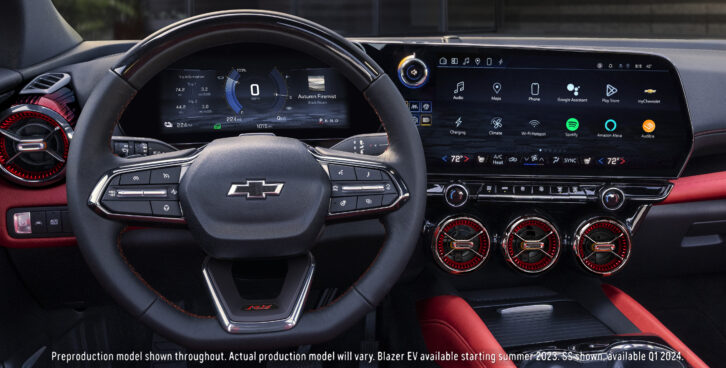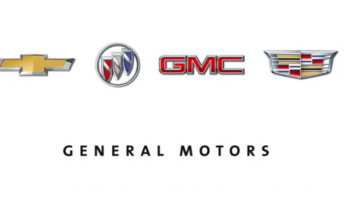With the broadcast industry and its allies in Washington turning up the heat on automakers to keep AM in cars, any glimpse into what automotive companies are thinking about the dashboard is important.
General Motors recently outlined its infotainment plans for new electric vehicles. Notably, the automaker says it will ditch phone projection systems for Apple CarPlay and Android Auto in a number of 2024 models.
In a media fact sheet in March, GM announced the move to an embedded Android Automotive system from Google in EVs. The strategy will not apply — for now — to internal combustion engine vehicles, according to the automaker.
“To help customers have seamless access to the full breadth of these experiences within our advanced in-vehicle displays, we will be integrating industry-leading applications such as Google Maps, Google Assistant, Amazon Music, Audible, Spotify, YouTube Music and more,” GM stated in the release.
GM’s announcement contained no mention of AM/FM radio capability in the infotainment strategy (and it was published prior to the introduction of legislation that would mandate the inclusion of AM).
However, a GM spokesperson told Radio World in a separate statement: “At this time, we continue to offer AM/FM radio, but are always evaluating what features and services we will offer on future vehicles. We also offer SiriusXM in new GM vehicles, as well as streaming radio content through apps like iHeartRadio, TuneIn and others.”
A different future in view
One observer found it notable that GM didn’t mention radio of any kind in its media release. Roger Lanctot, director of automotive connected mobility for Tech Insights, said the omission should be mildly alarming to broadcasters.
“It does cause one to — with good reason — read between the lines. The message is consistent with the recent Mercedes-Benz Operating System investor presentation of delivering most or all infotainment experiences via the embedded system in the car — i.e. the OnStar/cellular connection,” Lanctot says.
Lanctot also noted that the initial GM announcement didn’t mention satellite radio. “Clearly SiriusXM content can be delivered into the car via a GM store app instead of with the SiriusXM connectivity module and related antenna and software.”
Cellular connectivity will be king, he said, and radio should be preparing for a future that may be dependent at least in part upon cellular connectivity.
“I think it is important to take GM seriously — especially when it’s clear that they are responding to the interests of a large interested party such as Google,” he says.

The good news for radio broadcasters, according to Lanctot, is that things don’t happen very quickly in the automotive industry. “I expect cars will be equipped with FM (at least) radios, for the next five to six years,” he wrote in an email.
Auto industry observers say they believe other automakers are likely to follow GM’s “built-in tech” strategy, which is similar to how Tesla handles in-cabin infotainment, even though consumers have rejected previous OEM infotainment systems that didn’t work smoothly.
The National Association of Broadcasters is monitoring changes in the in-car entertainment space. It didn’t specifically comment on GM’s media release, but a spokesman for the trade group noted that its innovation arm, PILOT, completed its work on the broadcast radio interface within Android Automotive last year, in conjunction with Xperi.
GM says it is using Android Automotive as the base platform OS for infotainment experiences in GM EVs and gas/diesel vehicles. Google built-in applications as well as GM and other third-party Android applications also run on the platform, according to GM.
The NAB spokesman told Radio World that PILOT “focused on the broadcast framework, reference radio applications and a gap analysis outlining discrepancies and proposed solutions to be implemented in the Android Automotive operating system for full broadcast radio support globally.
“PILOT also initiated a technical review with the Android Automotive team. The initiative included broadcasters from the U.S., the U.K., the EU, Germany, Australia and Japan.”
It’s unclear what impact that project has had on the design of Android Automotive.
Embedded solutions
It’s no secret that Detroit automakers hope to reclaim territory in the dashboard once ceded to tech companies and instead use their own infotainment systems — in part to gather user data and collect subscription fees.
Nick Festa, GM’s director of digital business, told the Detroit News that the company’s new infotainment strategy exposes customers to an in-car digital experience.
“I would say it’s not about data per se, it’s about understanding,” Festa told the newspaper. “As we are trying to ramp up for vehicle capabilities like EV and energy management, like hands-free driving, like over-the-air software updates that we want to provide to our customers, having that understanding helps us make a better product.”
GM’s decision to not to include the phone projection systems next to Google’s built-in one in future EVs means it can scale its Ultifi software program, which includes next-gen digital interface and connectivity systems, according to the Detroit News story. Festa cited the consumer experience as a reason for dropping Apple CarPlay and Android Auto. “Customers [would] find themselves in situations where they’re bouncing back and forth in between different ecosystems for whatever job they’re seeking to accomplish,” Festa told the Detroit News.
In the March release, GM said its infotainment features and apps continue to evolve.
The shift to a “built-in and integrated infotainment experience” will begin with the 2024 Chevrolet Blazer EV, shipping this summer to dealers in the United State and Canada. The changes will apply to other EV launches this year including the 2024 Chevy Equinox and the new high-end 2024 Cadillac CELESTIQ. Plans also call for the 2025 GMC Sierra EV to include the Google-based infotainment system.
A GM spokesman said in a statement to Radio World: “An embedded solution allows customers to not only take advantage of infotainment options within the display, but integrates vehicle systems that aren’t possible through just phone projection.”
The automaker says a cornerstone of its infotainment strategy involves creating integrated experiences that transform how customers engage with their vehicles, such as controlling vehicle functions with voice commands, downloading the latest software updates and apps over the air, and focusing on simple and customizable screens that provide access to the larger GM ecosystem.
Edward Kummer, chief digital officer for GM, was quoted in the March release: “As we scale our EVs and launch our Ultifi software platform, we can do more than ever before with in-vehicle technologies and over-the-air updates. All of this is allowing us to constantly improve the customer experience we can offer across our brands.”
Apple users will be unable to download Apple-based apps, like Apple Music and Apple Podcasts, to GM’s new system in EVs. Customers with Apple and Android smartphones will continue to have access to hands-free calling, hands-free voice texting and streaming music through Bluetooth functionality in the vehicle.
“Customers can still connect to their phones using Bluetooth,” GM wrote to Radio World, “though the Google built-in system is very capable of helping them navigate, make phone calls, safely send and receive text messages, and access a broad selection of entertainment. Apple music, for instance, is still accessible via Bluetooth. With a phone paired, customers can activate Siri with voice commands and ask to play something from their Apple Music library.”
In related news, GM in May announced the hiring of former Apple executive Mike Abbott to lead its software development program. Abbott was VP of cloud services at Apple, according to a GM press release. In a statement, GM said Abbott “will lead a new integrated end-to-end software organization focused on digital delivery of services and features.”
The customizable car
Ultifi, mentioned in the text, was announced by General Motors in 2021 as “an end-to-end software platform designed to unlock new vehicle experiences and connect customers’ digital lives.”
The company says Ultifi enables frequent delivery of software-defined features, apps and services to customers over the air with an eye to building customer loyalty. It includes an app store. “Themes” allow the user to customize things like seating position, sounds and lighting; owners thus can personalize their cars like they can customize their smartphones.
The system builds on GM’s electrical architecture called Vehicle Intelligence Platform. “On top of this foundation, GM engineers will separate key software into a new centralized layer that acts as a powerful hub for vehicle systems,” GM said in 2021. “The Ultifi platform will then enable accelerated development and deployment of software and applications over the air to millions of customers, without affecting basic hardware controls.”
The image shown is from a GM video on YouTube.












